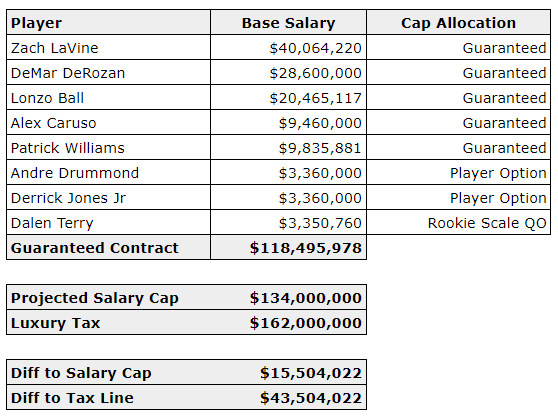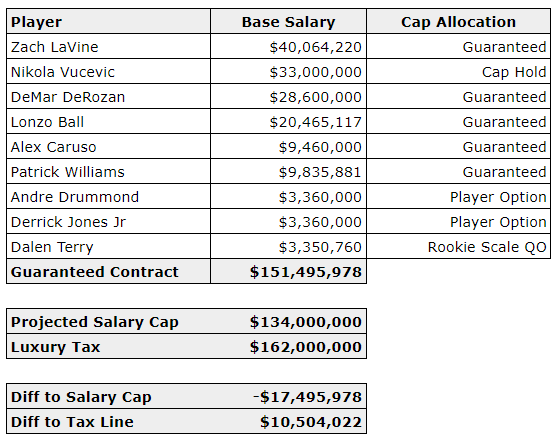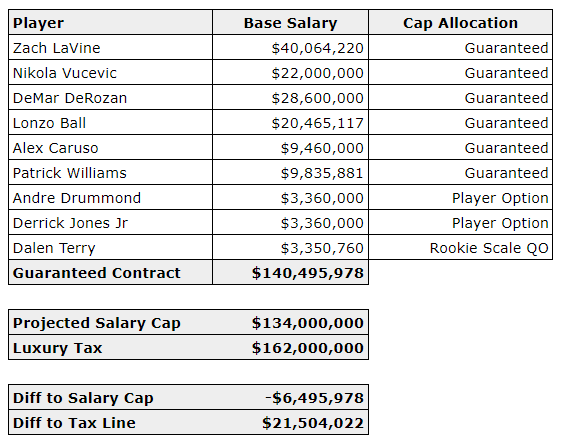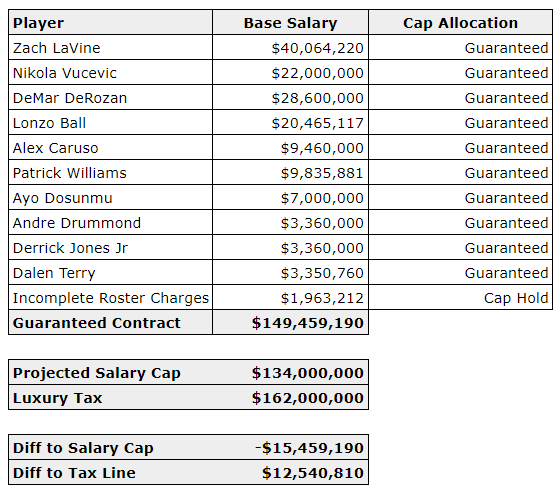© 2025 ALLCITY Network Inc.
All rights reserved.

The Bulls want you to believe that standing still at the deadline last week was the right decision.
Your favorite Bulls beat writer, Will Gottlieb, thoroughly debunked several pie-in-the-sky talking points that Bulls figureheads will be pushing over the coming days and weeks.
Allow me to pile onto the situation.
There was another very good and real reason why Chicago had to make a move at the deadline, and it hinges entirely on the financial inability to keep the current group intact.
You won’t catch me endorsing any strategy that involves the Bulls doing very little moving forward. However, assuming #continuity remains the focus into the offseason, the Bulls will not be able to keep everyone.
Decisions will need to be made. Someone has to go.
Knowing this begs an obvious question: If it’s not possible to pay everyone, in large part due to the luxury tax avoidance mandates set by ownership, why weren’t players moved at the deadline to recoup some value before the offseason?
As a follow up, does this now mean the Bulls could lose several players in the offseason for nothing?
The latter will be answered in time. As for the former, even if an answer is provided, it still makes little sense.
Nonetheless, in order to project what lies ahead, let’s break out the calculators and dive into some numbers.
The Bulls have a lot of guaranteed money
Before the offseason even begins, the Bulls will have $89.1 million dedicated to DeMar DeRozan, Zach LaVine and Lonzo Ball.
Alex Caruso, Patrick Williams and Dalen Terry account for an additional $22.6 million.
Should Andre Drummond and Derrick Jones Jr. opt into their the final year of their deals, the Bulls will have $118.5 million in guaranteed salaries committed to eight players (see below).

The Bulls will be operating above the cap
In the above scenario, the cap sheet suggests the Bulls are $15.5 million below the salary cap. In actuality, this isn’t true, specifically in any event which the Bulls attempt to retain its own free agents, namely Nikola Vucevic.
Vucevic has a sizeable cap hold ($33 million). In order to retain some control over his rights, the Bulls cap sheet must include the cap hold which has been assigned to its center.

Vucevic won’t receive a new contract that meets his cap hold amount. It will be a lesser amount. Once Vucevic inks this deal, his cap hold amount will be replaced by his new contract. For example, let’s assume Vucevic is retained to a deal similar to that which he is currently paid ($22 million). Despite a reduction to his accounting against the cap sheet, the Bulls still remain above the cap.

The above posits a scenario where the Bulls are over the cap, and are doing so for nine players. This is before considering any cap holds for Coby White, Ayo Dosunmu and Javonte Green. All three players will enter the offseason as free agents. There are also incomplete roster charges to factor into, too.
Starting to sense a theme?
The Bulls are going to run into money problems. The NBA does not have a hard cap in place. Though true, as we all know too well at this point, the luxury tax line has, and always will, act as a ceiling for this Bulls franchise.
Once your internal rage for the Reinsdorf family dissipates, continue with me on our thought experiment.
Let’s talk Dosunmu. He’ll be back in Chicago next season. Should the Bulls re-sign their second-year guard to a fair contract ($7 million), the franchise will creep even closer toward the tax.

Where do things sit now?
Ten players on the books for $149.5 million, leaving a buffer of $12.5 million between guaranteed contracts and the tax line. That’s nowhere near enough money to sign five additional players. Not meaningful, game-changing players, at least.
It’s certainly not enough space to retain White and Green, who, based on the above, are seemingly the odd men out.
This is why inactivity at the deadline cannot be justified
If the Bulls choose to retain Vucevic and Dosunmu — while keeping all other guaranteed contracts on the books — there is no way to re-sign White and Green while adding additional players to the roster without going into the tax.
I will eat a shoe if the Bulls go into the tax.
I’m that confident it won’t happen. Knowing this, it likely means that White and Green will be lost in free agency for nothing. Should this occur, which seems plausible, then why not trade them now for something, even if the return is modest?
Would a bevy of second-round picks not be more beneficial then losing players who cannot be retained due to financial constraints?
Perhaps the Bulls intend to re-sign White and Green. Maybe it will be others who are moved in order to stay under the tax line.
Drummond and Jones Jr. have shiftable contracts. Should they opt into their deals, both could be traded in the offseason. That’s fine, but why not do this now? Why not turn one of these guys into seldom-used Sixer, Furkan Korkmaz?
Korkmaz, who requested a trade several days ago, is hardly changing the fortunes of the franchise. He does, however, provide something the Bulls with bench scoring and shooting, two traits this team desperately needs. Korkmaz may be a lesser player than Jones Jr., but is his fit not more advantageous for the Bulls, who rank last in the league in 3-point attempts?
If Korkmaz — or any other end-of-bench role player — doesn’t float your boat, then trade the players who aren’t long for Chicago now. Doing so will recoup value in the form of draft picks, another commodity this team lacks. Grab some picks and preserve whatever room is left below the tax line to field the rest of the roster. That isn’t a lot to ask for.
And yet, the Bulls did nothing.
Again.
There’s no logical justification for such inaction, particularly for a team which has struggled to maintain a firm grip on play-in positioning.
The Bulls did nothing to fortify its current roster, nor have they adequately planned for the offseason.
Prepare for more of the same in the offseason. The numbers suggest as much.
Get Chicago's Best Sports Content In Your Inbox!Become a smarter Chicago sports fan with the latest game recaps, analysis and exclusive content from CHGO’s writers and podcasters!
Just drop your email below!
Comments
Share your thoughts
Join the conversation


